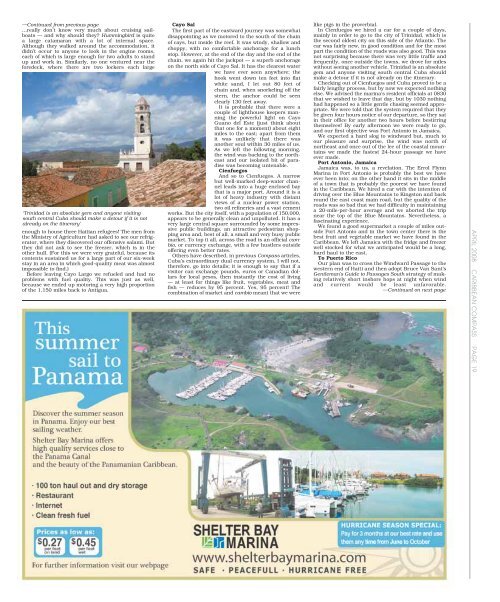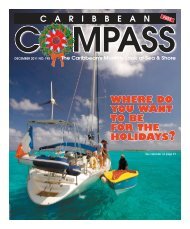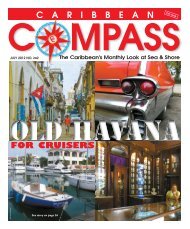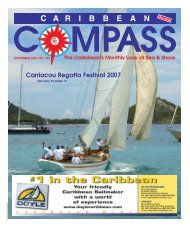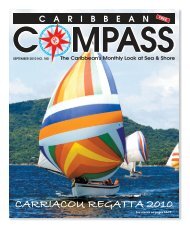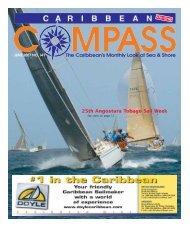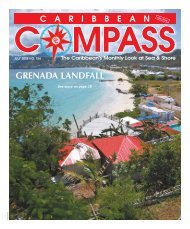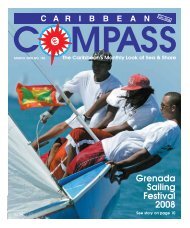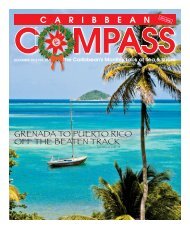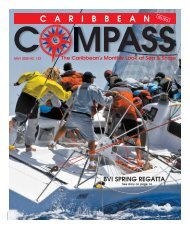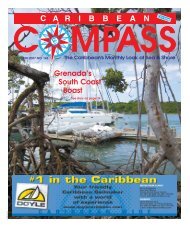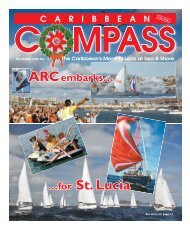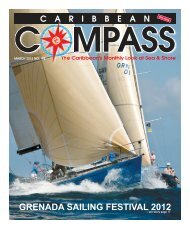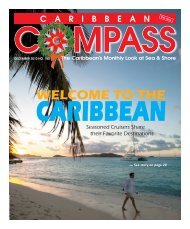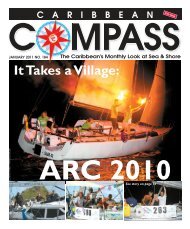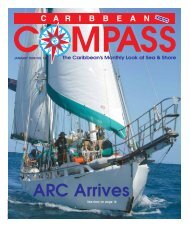Bequia Easter Regatta 2008 - Caribbean Compass
Bequia Easter Regatta 2008 - Caribbean Compass
Bequia Easter Regatta 2008 - Caribbean Compass
Create successful ePaper yourself
Turn your PDF publications into a flip-book with our unique Google optimized e-Paper software.
— Continued from previous page<br />
…really don’t know very much about cruising sailboats<br />
— and why should they? Hummingbird is quite<br />
a large catamaran with a lot of internal space.<br />
Although they walked around the accommodation, it<br />
didn’t occur to anyone to look in the engine rooms,<br />
each of which is large enough for two adults to stand<br />
up and work in. Similarly, no one ventured near the<br />
foredeck, where there are two lockers each large<br />
‘Trinidad is an absolute gem and anyone visiting<br />
south central Cuba should make a detour if it is not<br />
already on the itinerary’<br />
enough to house three Haitian refugees! The men from<br />
the Ministry of Agriculture had asked to see our refrigerator,<br />
where they discovered our offensive salami. But<br />
they did not ask to see the freezer, which is in the<br />
other hull. (For this we were very grateful, because its<br />
contents sustained us for a large part of our six-week<br />
stay in an area in which good-quality meat was almost<br />
impossible to find.)<br />
Before leaving Cayo Largo we refueled and had no<br />
problems with fuel quality. This was just as well,<br />
because we ended up motoring a very high proportion<br />
of the 1,150 miles back to Antigua.<br />
Cayo Sal<br />
The first part of the eastward journey was somewhat<br />
disappointing as we motored to the south of the chain<br />
of cays, but inside the reef. It was windy, shallow and<br />
choppy, with no comfortable anchorage for a lunch<br />
stop. However, at the end of the day and the end of the<br />
chain, we again hit the jackpot — a superb anchorage<br />
on the north side of Cayo Sal. It has the clearest water<br />
we have ever seen anywhere: the<br />
hook went down ten feet into flat<br />
white sand, I let out 80 feet of<br />
chain and, when snorkeling off the<br />
stern, the anchor could be seen<br />
clearly 130 feet away.<br />
It is probable that there were a<br />
couple of lighthouse keepers manning<br />
the powerful light on Cayo<br />
Guano del Este (just think about<br />
that one for a moment) about eight<br />
miles to the east; apart from them<br />
it was unlikely that there was<br />
another soul within 30 miles of us.<br />
As we left the following morning,<br />
the wind was backing to the northeast<br />
and our isolated bit of paradise<br />
was becoming untenable.<br />
Cienfuegos<br />
And so to Cienfuegos. A narrow<br />
but well-marked deep-water channel<br />
leads into a huge enclosed bay<br />
that is a major port. Around it is a<br />
lot of heavy industry with distant<br />
views of a nuclear power station,<br />
two oil refineries and a vast cement<br />
works. But the city itself, with a population of 150,000,<br />
appears to be generally clean and unpolluted. It has a<br />
very large central square surrounded by some impressive<br />
public buildings, an attractive pedestrian shopping<br />
area and, best of all, a small and very busy public<br />
market. To top it all, across the road is an official cambio,<br />
or currency exchange, with a few hustlers outside<br />
offering even better rates.<br />
Others have described, in previous <strong>Compass</strong> articles,<br />
Cuba’s extraordinary dual currency system. I will not,<br />
therefore, go into details; it is enough to say that if a<br />
visitor can exchange pounds, euros or Canadian dollars<br />
for local pesos, then instantly the cost of living<br />
— at least for things like fruit, vegetables, meat and<br />
fish — reduces by 95 percent. Yes, 95 percent! The<br />
combination of market and cambio meant that we were<br />
like pigs in the proverbial.<br />
In Cienfuegos we hired a car for a couple of days,<br />
mainly in order to go to the city of Trinidad, which is<br />
the second oldest city on this side of the Atlantic. The<br />
car was fairly new, in good condition and for the most<br />
part the condition of the roads was also good. This was<br />
not surprising because there was very little traffic and<br />
frequently, once outside the towns, we drove for miles<br />
without seeing another vehicle. Trinidad is an absolute<br />
gem and anyone visiting south central Cuba should<br />
make a detour if it is not already on the itinerary.<br />
Checking out of Cienfuegos and Cuba proved to be a<br />
fairly lengthy process, but by now we expected nothing<br />
else. We advised the marina’s resident officials at 0830<br />
that we wished to leave that day, but by 1030 nothing<br />
had happened so a little gentle chasing seemed appropriate.<br />
We were told that the system required that they<br />
be given four hours notice of our departure, so they sat<br />
in their office for another two hours before bestirring<br />
themselves! By early afternoon we were ready to go,<br />
and our first objective was Port Antonio in Jamaica.<br />
We expected a hard slog to windward but, much to<br />
our pleasure and surprise, the wind was north of<br />
northeast and once out of the lee of the coastal mountains<br />
we made the fastest 24-hour passage we have<br />
ever made.<br />
Port Antonio, Jamaica<br />
Jamaica was, to us, a revelation. The Errol Flynn<br />
Marina in Port Antonio is probably the best we have<br />
ever been into; on the other hand it sits in the middle<br />
of a town that is probably the poorest we have found<br />
in the <strong>Caribbean</strong>. We hired a car with the intention of<br />
driving over the Blue Mountains to Kingston and back<br />
round the east coast main road, but the quality of the<br />
roads was so bad that we had difficulty in maintaining<br />
a 20-mile-per-hour average and we aborted the trip<br />
near the top of the Blue Mountains. Nevertheless, a<br />
fascinating experience.<br />
We found a good supermarket a couple of miles outside<br />
Port Antonio and in the town center there is the<br />
best fruit and vegetable market we have found in the<br />
<strong>Caribbean</strong>. We left Jamaica with the fridge and freezer<br />
well stocked for what we anticipated would be a long,<br />
hard haul to the east.<br />
To Puerto Rico<br />
Our plan was to cross the Windward Passage to the<br />
western end of Haiti and then adopt Bruce Van Sant’s<br />
Gentleman’s Guide to Passages South strategy of making<br />
relatively short inshore hops at night when wind<br />
and current would be least unfavorable.<br />
—Continued on next page<br />
APRIL <strong>2008</strong> CARIBBEAN COMPASS PAGE 19


